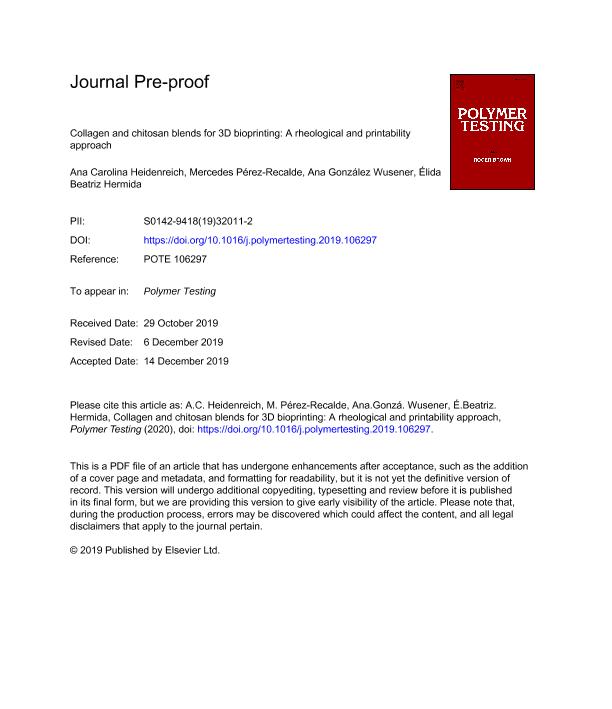Mostrar el registro sencillo del ítem
dc.contributor.author
Heidenreich, Ana Carolina

dc.contributor.author
Pérez Recalde, Mercedes
dc.contributor.author
González Sánchez Wusener, Ana Elena

dc.contributor.author
Hermida, Elida Beatriz

dc.date.available
2022-04-04T13:42:39Z
dc.date.issued
2019-12
dc.identifier.citation
Heidenreich, Ana Carolina; Pérez Recalde, Mercedes; González Sánchez Wusener, Ana Elena; Hermida, Elida Beatriz; Collagen and chitosan blends for 3D bioprinting: A rheological and printability approach; Elsevier; Polymer Testing; 82; 106297; 12-2019; 1-29
dc.identifier.issn
0142-9418
dc.identifier.uri
http://hdl.handle.net/11336/154251
dc.description.abstract
Collagen and chitosan are widely employed as biomaterials, including for 3D-bioprinting. However, the use of collagen and chitosan (col:chi) blends as bioinks is still scarce. In this work, the rheology of different hydrogel precursors (0.5–1.50% w/v chi: 0.18–0.54% w/v col) was analyzed through frequency and strain sweeps, as well as at different shear rates. Col:chi blends showed a shear-thinning behavior, with viscosity values at low shear rates between 0.35 and 2.80 Pa s. Considering the strain rate determined by the applied flow in a 3D-bioprinter, precursor viscosities during the extrusion were in the interval 0.5–0.8 Pa s. Printability (Pr) was measured comparing images of the printed meshes and the corresponding CAD grid design, using photograph analysis. Col:chi 0.36:1.00 was chosen to print mono-layered scaffolds for tissue engineering (TE) because of its suitable viscosity, printability and polymer ratio content. Hydrogels were obtained through NaHCO3 nebulization and 37° incubation, and NHS/EDC were added to obtain scaffolds with improved mechanical behavior. They were stable after 44 h in PBS with collagenase at physiological level and showed no cytotoxic effect in NIH-3T3 fibroblasts.
dc.format
application/pdf
dc.language.iso
eng
dc.publisher
Elsevier

dc.rights
info:eu-repo/semantics/openAccess
dc.rights.uri
https://creativecommons.org/licenses/by-nc-nd/2.5/ar/
dc.subject
3D BIOPRINTING
dc.subject
HYDROGEL PRECURSOR
dc.subject
RHEOLOGY
dc.subject
COLLAGEN
dc.subject
CHITOSAN
dc.subject
BIOINKS
dc.subject.classification
Biomateriales

dc.subject.classification
Biotecnología de la Salud

dc.subject.classification
CIENCIAS MÉDICAS Y DE LA SALUD

dc.title
Collagen and chitosan blends for 3D bioprinting: A rheological and printability approach
dc.type
info:eu-repo/semantics/article
dc.type
info:ar-repo/semantics/artículo
dc.type
info:eu-repo/semantics/publishedVersion
dc.date.updated
2020-11-20T18:05:44Z
dc.journal.volume
82
dc.journal.number
106297
dc.journal.pagination
1-29
dc.journal.pais
Países Bajos

dc.journal.ciudad
Amsterdam
dc.description.fil
Fil: Heidenreich, Ana Carolina. Universidad Nacional de San Martin. Escuela de Ciencia y Tecnologia. Laboratorio de Biomateriales, Biomecanica y Bioinstrumentacion.; Argentina. Consejo Nacional de Investigaciones Científicas y Técnicas; Argentina
dc.description.fil
Fil: Pérez Recalde, Mercedes. Universidad Nacional de San Martin. Escuela de Ciencia y Tecnologia. Laboratorio de Biomateriales, Biomecanica y Bioinstrumentacion.; Argentina
dc.description.fil
Fil: González Sánchez Wusener, Ana Elena. Consejo Nacional de Investigaciones Científicas y Técnicas. Centro Científico Tecnológico Conicet - La Plata. Instituto de Investigaciones Biotecnológicas. Universidad Nacional de San Martín. Instituto de Investigaciones Biotecnológicas; Argentina
dc.description.fil
Fil: Hermida, Elida Beatriz. Universidad Nacional de San Martin. Escuela de Ciencia y Tecnologia. Laboratorio de Biomateriales, Biomecanica y Bioinstrumentacion.; Argentina. Consejo Nacional de Investigaciones Científicas y Técnicas; Argentina
dc.journal.title
Polymer Testing

dc.relation.alternativeid
info:eu-repo/semantics/altIdentifier/doi/http://dx.doi.org/10.1016/j.polymertesting.2019.106297
dc.relation.alternativeid
info:eu-repo/semantics/altIdentifier/url/https://www.sciencedirect.com/science/article/abs/pii/S0142941819320112
Archivos asociados
